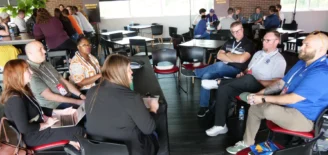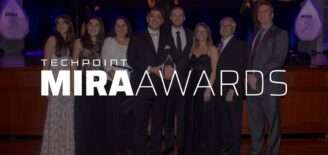How Star Wars Continues to Inspire 45 Years After Debut
Among the many cherished films throughout history that members of the tech community hold in high regard, few franchises come close to the reverence held for George Lucas’ galaxy far, far away. Star Wars turns 45 years old tomorrow, Wednesday, May 25, 2022, and in the years that have passed since that iconic opening title scrawl, millions of people worldwide have fallen in love with the franchise.
We talked with five of them, all members of the Indiana tech ecosystem, and asked them how the films have impacted their lives and their paths to working in tech. While none of these five tech professionals were there on May 25, 1977, for the original film’s debut, the 10 films, growing number of television series and dozens of novels and video games about Star Wars have nevertheless played an immeasurable role in their lives.
For those of you who are not familiar with Star Wars, it is important to note that the first three films released between 1977-1983 are known as the “Original Trilogy” and consist of Episodes IV, V, and VI. The second trilogy released from 1999-2005, consisting of Episodes I, II, and III, are referred to as the “Prequel Trilogy”. And the final trilogy released between 2015-2019, consisting of Episodes VII, VIII, and IX, are referred to as the “Sequel Trilogy”. There have also been two stand-alone films.
“You’ve taken your first step into a larger world”
Sabra Rathbun remembers watching the first three Star Wars films on VHS with her dad. “[I would pretend] old paper towel rolls were lightsabers, and hit anything and everything with them,” said the application developer with DB Services. “I was a younger child around the time the prequels came out, so I thought Darth Maul with his dual-bladed lightsaber was the coolest person in existence.”
“I watched the Original Trilogy more times than I could count as a kid,” said Rutledge Daugette, account manager with GadellNet Consulting Services. “I saw Episode I 11 times in theaters and the subsequent films a few times as well. I grew up with plenty of Star Wars, and deeply enjoyed the lore and encyclopedias that showcased the tech inside ships and vehicles, as well as collecting almost all of the Extended Universe books from middle school up until now! I have a huge collection.”
Seeing Star Wars: Episode I – The Phantom Menace in theaters proved a common experience for our five Indiana tech professionals. Dressed up as infamous armored villain Darth Vader, Charles Penn, senior test engineer with SEP, remembers standing in line for at least an hour to see the film’s release with his father in Franklin, Ind.
Jared Hess, director of business intelligence with Ship Sigma, knew that Episode I would be coming out on his birthday, May 19, so he stayed up all night the night before with his mother watching the Original Trilogy to get “caught up.”
“Try not. Do or do not. There is no try.”
Science fiction has always inspired humanity to reach for new heights, and to push the boundaries of what’s considered possible. Star Wars is no different, and for the last 45 years it has helped open the eyes of countless individuals to the vast expanses of opportunities found in science, technology, engineering, and mathematics (STEM) fields.
“[The films] had such a fundamental impact on me,” said Troy Wiegand, automation engineer with Kinney Group, Inc. “Seeing Anakin [Skywalker] being able to build droids and racing pods. Well, it was quite ‘Wizard’. You get it in your head that you could do something like that. I could work on androids or space lasers.”
“I think the technical possibilities that Star Wars showcases push anyone, anywhere, to dream big,” said Daugette. “We’ve seen people create real lightsabers, discover hover technology that we’ve seen from Landspeeders, and even jetpacks that make you look like a Mandalorian. While not everything is practical, the way that Star Wars can pique the imagination is enough to inspire younger people to dream big.”
Lightsabers, “an elegant weapon for a more civilized age” as Obi-Wan Kenobi called them, are one of the most iconic film weapons in popular culture and are something many fans of the franchise have tried to create.
“I had always been interested in the process of making a lightsaber, from the kyber crystals, to the ‘bonding’ ritual with the crystal,” said Rathbun. “The films really just furthered my love for building things, and now as an adult, I have actually built my own lightsaber.”
Star Wars, and other beloved franchises such as Star Trek, Battlestar Galactica, Dune and Stargate, serve not only as personal inspiration but as things that unite and bring people together.
“I think it connected a lot of folks who were interested in STEM fields,” said Penn. “[Star Wars] has a lot to offer various disciplines! Alien biology, the mechanical engineering of starfighters, the artificial intelligence of Droids; all of these have sparked the urge to learn more from people I’ve met!”
“The impact Star Wars has had is immeasurable,” said Wiegand. “The amount of science fiction references I hear on a day to day basis at work is astronomical. It’s sewn into the DNA of the STEM mindset. They inspire us to push the boundaries and think in ways we wouldn’t otherwise.”
“I hope that we get an opportunity to see more unique Star Wars stories, like Rogue One, and delve deeper into some of the cooler tech that we’ve seen from the series,” said Daugette. “With a ton of new shows planned, I think geeks are in for a great time!”
Many aspects of George Lucas’ galaxy far, far away have in certain ways truly come to life, while other parts of the franchise (such as lightspeed travel) remain impossible or, at best, theoretical. What is not theoretical is the positive impact it has had on the Indiana tech workforce by inspiring Star Wars fans to pursue tech careers. That inspiration, and the community it creates, may someday make the impossible possible.






